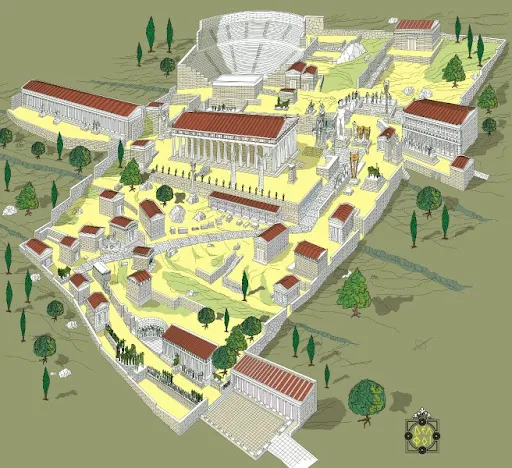Delphi - The Treasury of the Athenians
23) The Treasury of the Athenians
490 - 485 B.C.
The Treasury of Athens is the most famous of Delphi Treasuries and one of the few whose original building material and decoration has been preserved.
It was restored by the French Archaeological School in 1905-1906 after the great excavations with funding from the modern Athens Municipality.
The Treasury of the Athenians
It is believed that the Treasury was built around 490 - 485 B.C. on the foundations of an older treasure, which the Athenians had founded in the years of Solon, around 580 B.C.
The Sacred Way and the Treasury of the Athenians view from the North
Its dimensions are 6,621 x 9,687meters, and it has been made entirely with marble from the island of Paros. It consists of the cella* and the pronaos*. Two doric order columns, 4 meters in height at the facade, between the pilasters, hold the entablature with rich sculptural decoration.
A colored reconstruction of the building
The sculptural decoration of the Treasury consisted of thirty beautiful metopes* among the triglyphs, six on the small sides and nine on the long sides, all of them were saved however, they were not well preserved. The metopes are reproductions; the originals are exhibited at Museum of Delphi.
Each metope depicts scenes from the adventures of Heracles and of Theseus, as well as , from Amazonomachies. All of them together comprise the adventures and feats of the two heroes as independent scenes from a great ongoing adventure that continues from metope to metope on each side.
Heracles is depicted, on the north and west sides and equally divided on the south and east sides is Theseus, the mythical ancestor and beloved hero of Athens, who was given a more prominent position towards the side of the Sacred way.
Thesean metopes include:
- Theseus and Athena
- Theseus and Sinis
- Theseus and the Crommyonian sow
- Theseus and Sciron
- Theseus and Cercyon
- Theseus and Procrustes
- Theseus and the Bull of Marathon
- Theseus and the Minotaur
- Theseus and the Captive Amazon
Amazon Antiope. Metope 8. The hero, a mantle, himation, draped over his back, is poised to deliver the final blow to the Amazon who has fallen on her shield.
Heraklean metopes include:
- Heracles and the Nemean Lion
- Heracles and the Ceryneian Hind
- Heracles and the Centaur
- Heracles and Cycnus
- Heracles and Orthrus
- Cows of Geryon (three metopes)
- Geryon
Heracles and Cycnus
On the base platform of the Treasure were columns engraved with scripted texts and on the southern side there were other various inscriptions, honorific votes for the Athenians, descriptions of the Pythaitha and two hymns* to Apollo with musical symbols, unique sources of ancient Greek music (today they are exhibited in the Delphi Archaeological Museum).
The hymns to Apollo inscriptions
the Marathon votive
On the south face of the Treasury, a triangular base with ten places bears the inscription:
ΑΘΕΝΑΙΟΙ Τ[Ο]Ι ΑΠΟΛΛΟΝ[Ι ΑΠΟ ΜΕΔ]ΟΝ ΑΚ[ΡΟΘ]ΙΝΙΑ ΤΕΣ ΜΑΡΑΘ[Ο]ΝΙ Μ[ΑΧΕ]Σ
(= The Athenians dedicated this to Apollo as first-fruits from the Persians at the Battle of Marathon
The Navel, the Marathon votive and the treasury of the Athenians. View from the Southwest.
Cella: (from Latin for small chamber) or naos (from the Greek ναός, "temple") is the inner chamber of an ancient Greek or Roman temple in classical antiquity.
Pronaos and opisthodomos: In front of the naos, there is a porch, the pronaos, created by the protruding side walls of the naos (the antae), and columns placed between them. A door allows the naos to be accessed from the pronaos. A similar room at the back of the naos is called the opisthodomos. There is no door connecting the opisthodomos with the naos; its existence is necessitated entirely by aesthetic considerations: to maintain the consistency of the peripteral temple and to ensure its visibility from all sides, the execution of the front has to be repeated at the rear. A restricted space, the adyton, may be included at the far end of the naos, backing up on the opisthodomos.
metope: a rectangular architectural element that fills the space between two triglyphs in a Doric frieze, which is a decorative band of alternating triglyphs and metopes above the architrave of a building of the Doric order.
Hymnhymn: a metric composition whose text addresses a god, either directly or indirectly. They are the earliest formal type in Greek music, and survive in relatively large numbers
support us - buy the map!

The reconstruction poster map of Delphi,
by the Archaeological Guide of Greece
Poster size: 85X56cm / 34X22in
Designed and produced for a convenient and handy use in site and at home, it will assist you to visualize the Sanctuary of Apollo, where theOracle of Delphi was, the Ancient Theater, the Stadion, the Gymnasion of Delphi and the Sanctuary of Athena Pronaia.
price: 20€










